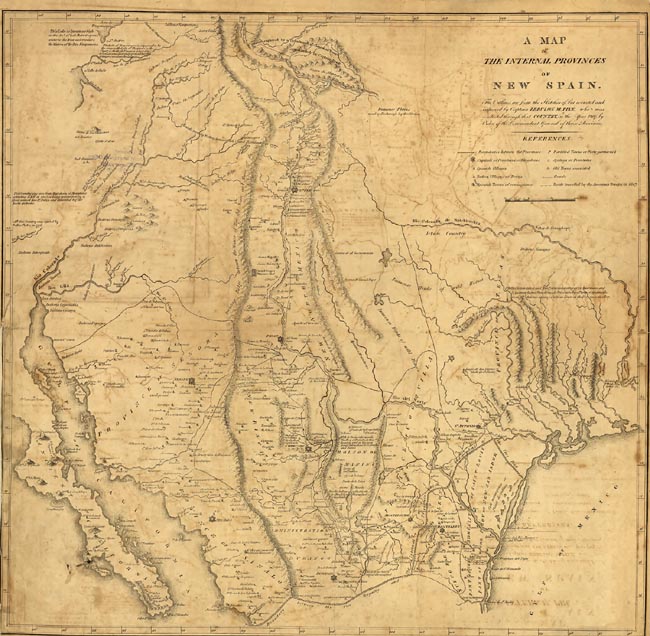War With Spain Avoided
![]()
This Site:
The History of Texas: Hostilities with Spain Avoided(Previous Section: First White Settlements) Map of New Spain, Showing the Territory Disputed between the United States and Spain(Click on Map for a detailed View) ON the receipt of the order of the secretary of war, of the 20th of November, 1805, Major Porter made known to Governor Cordero, at Nacogdoches, the limit beyond which he could not pass, and required of him an assurance that the Spanish troops would not cross the Sabine. The governor answered the letter on the 4th of February, 1806, refusing the assurance demanded. In the meantime, however, on the 1st of February, Major Porter dispatched Captain Turner, with sixty men, to the Adaes, to compel any Spanish force he might find there to withdraw beyond the Sabine; but directed him to avoid the spilling of blood, if it could be prevented. Captain Turner reached the Adaes before noon on the 5th. The Spanish patrol having given notice of Turner's approach, he found their men in some confusion. They saddled, mounted, and formed. A conference was held; and, after a good deal of altercation, Ensign Gonzalez consented to retire beyond the Sabine, and Captain Turner gave him three hours to prepare to march. He begged for time to hunt his horses, but was informed that he could send back two or three of his men for them; so he set out on his march. The next day Captain Turner advanced toward the Sabine, and, three miles from the Adaes, overtook the Spanish ensign, who excused himself from proceeding on account of his lost horses. Captain Turner, not wishing to trust him further, took his written promise to retire beyond the Sabine. The Spanish authorities, on receiving intelligence of this expulsion, hastened their preparations to march to the disputed point. Governor Herrera, with his quota of thirteen hundred men from New Leon, and Governor Cordero, with a smaller force, advanced to the Sabine, and crossed that river about the first of August, 1806. Colonel Cushing, then in command at Natchitoches, addressed Governor Herrera a letter, warning him that if he did not retire beyond the Sabine, he would be considered an invader of the territory of the United States. This letter reached Herrera at the plantation of Mr. Prudhomme, a few miles only from Natchitoches. On the next day (August 6th), Herrera replied, charging the government of the United States with usurping the territory of Spain, but stating that his orders were not to break the good understanding which subsisted between the two countries. In the meantime, Governor Claiborne had called out the militia of Louisiana, and reached Natchitoches with a considerable reinforcement about the 25th of August. He likewise addressed a letter to Governor Herrera, in which he enumerated many evidences of an unfriendly feeling on the part of Spain toward the United States, and assured him that, if he persisted in his aggression on the east of the Sabine, he might readily anticipate the consequences. Governor Herrera replied on the 28th of August, denying and excusing the charges of unfriendly feeling on the part of Spain. By this time, General James Wilkinson arrived with additional forces at Natchitoches, and assumed the command. On the 24th of September, he addressed to Governor Cordera a final and decisive letter, and, in a tone which could not be misunderstood, demanded the immediate withdrawal of the Spanish troops to the west side of the Sabine. This letter was directly transmitted to General Salcedo: but, in the meantime, the Spanish forces fell back to the right bank of the Sabine, where they took their position; and, on the 22d of October, General Wilkinson set out on his march from Nachitoches, and established his quarters on the left bank of that river. The two armies being separated only by the stream, and the commander on each side acting under positive orders from his government, seemed to render a conflict unavoidable. Herrera called a council of war, laid before them the orders of the viceroy and the commandant-general, and asked their advice. They were unanimous in the opinion that they should commence a predatory warfare, but avoid a general engagement. Herrera, in opposition to this view of the council, entered into an agreement with General Wilkinson, that, until the question of boundary between the two governments was settled, all the territory between the Sabine and the Arroyo Honda should be a neutral ground, not to be occupied by either party: and thus a conflict was avoided. The agreement was approved by both governments, and General Herrera actually received the thanks of the viceroy for his conduct in the affair. The fortunate conclusion of this campaign, together with the fact that Spain recognized the doctrine that the flag protected the cargo, to which may be added the fearful war then ravaging Europe, produced a temporary calm in the relations between this power and the United States. [Next Section of Texas History: Zebulon Pike Expedition] |
![]()
|
Site Copyright © 2003-2018 Son of the South. For questions or comments, contact paul@sonofthesouth.net. |
|
|
|
Are you Scared and Confused? Click Here to read My Snake Story, a story of hope and encouragement, to help you face your fears. |
||
